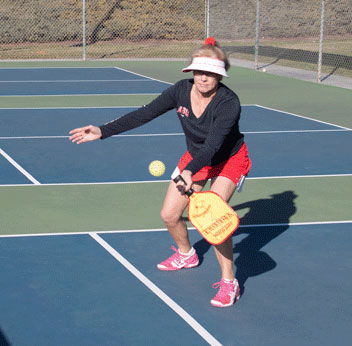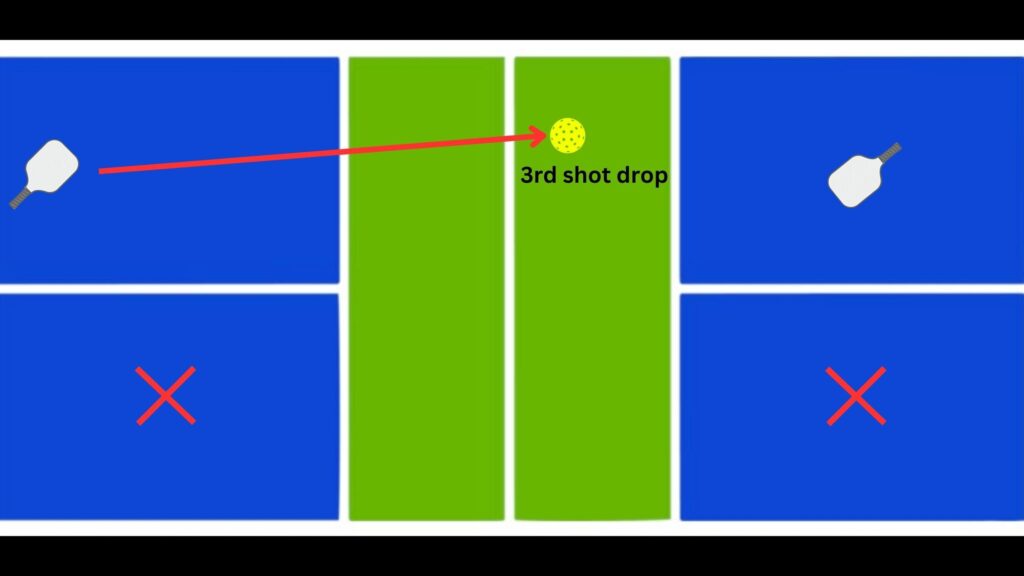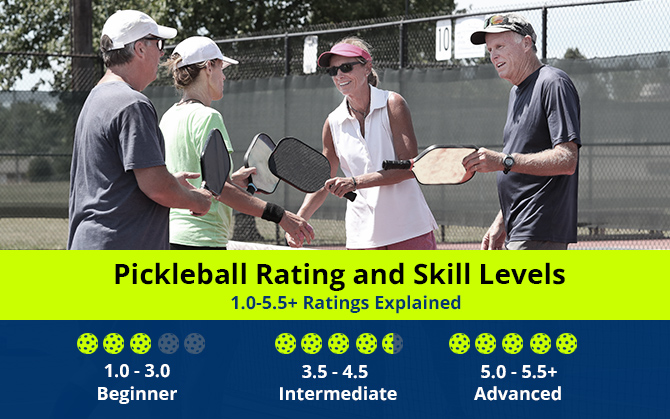A volley in pickleball is when a player hits the ball in mid-air before it bounces. It is a crucial move that requires quick reflexes and precise timing.
Welcome to the exciting world of pickleball! Whether you are a beginner or a seasoned player, understanding the various terms used in the game is essential. One such term is “volley. ” In pickleball, a volley occurs when a player hits the ball in mid-air, before it touches the ground.
Unlike in tennis, where volleys are typically used closer to the net, in pickleball, volleys can happen at any point during the game. Mastering the volley is vital as it allows players to take control of the game and maintain an offensive position. This article will delve deeper into the significance of the volley, its rules, techniques, and strategic implications. So, get ready to elevate your pickleball skills by understanding the ins and outs of the volley.

Credit: www.pickleballuniversity.com
What Is Pickleball
Pickleball is a paddle sport that combines elements of tennis, badminton, and table tennis. It is played on a court with a similar size to a badminton court, and the net is slightly lower than in tennis. The game can be played both indoors and outdoors and is suitable for people of all ages and skill levels. One of the key factors that make pickleball so enjoyable is that it is easy for beginners to learn, but can develop into a quick, fast-paced game for experienced players.
Brief History
The birth of pickleball can be traced back to 1965 when Joel Pritchard, a congressman from Washington, and his friend Bill Bell, discovered their families were bored and restless on a summer weekend. They attempted to set up the badminton net but couldn’t find all the equipment. To improvise, they began to play with ping-pong paddles and a perforated plastic ball. Soon, they created the rules and introduced the game to their friends, and it became widely popular. Today, pickleball is played across the globe by millions of people.
Rules And Equipment
- The court is similar in size to a badminton court, 20 feet wide and 44 feet long.
- The net is placed at 36 inches at the ends and 34 inches at the center.
- Players use solid paddles made of wood, graphite, or composite materials to hit a lightweight plastic ball over the net.
- The serve must be made underhand, and the server must keep both feet behind the back line when serving.
- Scoring is simple, and the first side to reach 11 points with a 2-point lead wins the game.
Understanding the history, rules, and equipment of pickleball provides a solid foundation for diving into the gameplay and strategies of this rapidly growing sport.
Understanding The Basics Of Volley
A volley is an essential skill in the game of pickleball. It refers to hitting the ball in mid-air without allowing it to bounce on the court. Mastering the volley is crucial to excel in pickleball and it adds an exciting dimension to the gameplay. In this section, we will delve deeper into the definition of a volley and explore its importance in gameplay.
Definition
In pickleball, a volley refers to hitting the ball before it bounces on the court. Players often position themselves near the non-volley zone, commonly known as the kitchen, to execute volleys effectively. The goal is to maintain control over the ball and prevent your opponents from gaining an advantage.
Importance In Gameplay
The volley plays a vital role in pickleball as it allows players to maintain their strategic position on the court. By hitting the ball in mid-air, you gain better control over your shots and can dictate the direction and pace of the game. Volleys are often used to execute quick, aggressive shots, putting pressure on the opponents to react swiftly. They also provide an opportunity to create winning opportunities by placing the ball strategically in hard-to-reach areas of the court.
Additionally, volleys allow you to neutralize your opponent’s powerful shots effectively. Instead of waiting for the ball to bounce and potentially lose control, you can intercept the shot mid-air and redirect it with precision. This defensive technique can keep you in control of the rally and give you a competitive edge.
Mastering volleys not only enhances your gameplay but also enhances your overall pickleball experience. The ability to execute well-timed volleys can lead to intense and exhilarating rallies. It allows for faster-paced matches, making the game more challenging and enjoyable for players of all skill levels.
Now that we have a clear understanding of what a volley is and its significance in pickleball, let’s delve into the technical aspects of executing this essential shot.
Techniques For Solid Volley
Mastering the technique of the volley is one of the key skills in pickleball. A well-executed volley can make a significant difference in the outcome of the game. In this section, we will explore two important aspects of the volley: proper grip and stance, and timing and anticipation.
Proper Grip And Stance
Having the correct grip and maintaining a balanced stance are essential for a solid volley. Here are some key points to keep in mind:
- Grip: Hold the paddle with a firm but relaxed grip. The handshake grip, where the paddle handle rests diagonally across your palm, is commonly used for volleys. Ensure that your grip is not too tight, as it can restrict your wrist movement and affect your shot accuracy.
- Stance: The ready position for the volley requires you to be in a slightly open stance, with your feet shoulder-width apart. Keep your knees slightly bent and your weight evenly distributed on both feet. This stance provides stability and flexibility, allowing you to react quickly to the ball.
Timing And Anticipation
Timing is crucial in executing a successful volley. Anticipating the direction and speed of the ball can greatly improve your timing. Consider the following:
- Watch the ball: Focus on the ball from the moment it leaves your opponent’s paddle. By closely tracking the ball, you can better anticipate its trajectory and make split-second decisions regarding your volley technique.
- Footwork: Proper footwork is essential for timing and staying balanced. Be light on your feet and be prepared to move quickly. Adjust your stance and position yourself in a way that maximizes your reach and allows for efficient volley execution.
- Practice timing drills: Incorporate timing drills into your practice sessions to improve your reaction time. These drills can involve a partner or a ball machine and simulate various volley scenarios.
By combining a proper grip and stance with effective timing and anticipation, you can enhance your volleying skills in pickleball. Consistent practice and an understanding of these techniques will contribute to a more solid and efficient volley, advancing your game to the next level.
Common Mistakes To Avoid

Volley is a crucial technique in pickleball that requires precision, control, and strategy. However, many players often make common mistakes that hinder their performance on the court. By understanding and actively avoiding these mistakes, you can greatly improve your volley skills and elevate your gameplay. Let’s delve into some of the most common errors that players should steer clear of when executing volleys.
Hitting The Ball Too Hard
One prevalent mistake among pickleball players, especially beginners, is hitting the ball too hard during a volley. Overexerting force can result in the ball sailing out of bounds or into the net, leading to missed opportunities and lost points. It’s essential to focus on controlled, precise shots rather than raw power. By practicing restraint and finesse, players can achieve more accuracy and better placement, ultimately gaining an edge in their matches.
Failure To Maintain Balance
Another common mistake is the failure to maintain balance while performing a volley. Many players tend to lunge or reach excessively, causing them to lose their stability and positioning. This lack of balance not only impacts the quality of the shot but also leaves players vulnerable to counterattacks from their opponents. By prioritizing proper footwork and body positioning, players can enhance their stability, allowing for more effective and consistent volleys.
Advanced Volley Strategies
When it comes to pickleball, mastering the art of the volley is essential to elevate your game. While beginners focus on the basic volley technique, advanced players delve into strategic approaches to gain an edge on the court. In this article, we will explore advanced volley strategies in pickleball, including dinking technique and attacking volleys. By incorporating these strategies into your game, you will become a formidable opponent on the court.
Dinking Technique
The dink shot is a crucial strategy that involves the gentle placement of the ball over the net, often employed during a slow-paced rally. Mastering the dinking technique requires finesse and precision. Here are some advanced strategies to enhance your dinking game:
- Maintain a soft grip on your paddle to ensure better control and feel of the ball.
- Focus on a gentle touch rather than a forceful hit to keep the ball low and close to the net.
- Use your wrist to generate spin on the ball, causing it to drop quickly upon crossing the net.
- Observe your opponent’s positioning to determine the most effective placement of your dink shots.
Attacking Volleys
Attacking volleys are aggressive shots aimed at overpowering your opponents and scoring points. To incorporate attacking volleys into your pickleball strategy, consider the following advanced techniques:
- Position yourself closer to the net to reduce the reaction time for your opponents.
- Generate power by stepping into the shot and transferring your weight from the back foot to the front foot.
- Focus on hitting the ball at an angle, aiming for the sidelines or the body of your opponents to create difficulty in returning.
- Anticipate your opponent’s shots by studying their movement patterns and positioning on the court.
By mastering the dinking technique and incorporating attacking volleys into your strategy, you can gain control of the game and dominate the court. Remember, practice makes perfect. Experiment with these advanced volley strategies during your training sessions and watch your pickleball skills soar to new heights.

Credit: www.rookieroad.com
Frequently Asked Questions On What Is A Volley In Pickleball
What Does It Mean To Volley A Ball In Pickleball?
Volleying a ball in pickleball means hitting it in the air before it bounces. It’s a common technique used to maintain control of the game and strategically place the ball.
How Do You Volley In Pickleball For Beginners?
To volley in pickleball for beginners, stand near the non-volley zone. Use a slight knee bend, keep your paddle up, and position your body towards the net. Focus on timing and making contact with the ball in front of your body.
Practice helps improve your technique.
How Do You Hit A Volley Shot In Pickleball?
To hit a volley shot in pickleball, position yourself near the net and keep your paddle up. Anticipate the ball’s trajectory and position yourself accordingly. Use a short backswing and a quick, controlled motion to strike the ball just before it bounces.
Maintain a balanced stance and follow through with the shot.
What Is The No Volley Zone In Pickleball?
The no volley zone in pickleball is an area near the net where players cannot hit the ball out of the air. It extends seven feet from the net on both sides and helps promote fair and strategic gameplay. Stay out of this zone to keep the game balanced and follow the rules.
Conclusion
The volley is a crucial skill in pickleball that requires precise timing and positioning. It allows players to maintain control of the game and outmaneuver their opponents. Mastering the art of volleying takes practice and dedication, but it significantly enhances a player’s performance on the court.
Keep honing this skill to elevate your game!
Neil jacobson is an avid Pickleball enthusiast, writer, and coach dedicated to sharing the joy and intricacies of the sport. With 6 years of experience on the court and a passion for teaching, Courtney brings a unique perspective to his writing, offering practical insights and strategies for players of all levels. As a certified Pickleball coach, his mission is to inspire and empower individuals to excel in the game while fostering a sense of community within the Pickleball world. Through his articles, guides, and coaching sessions, Neil aims to elevate the playing experience and share the infectious enthusiasm that defines the Pickleball community.




